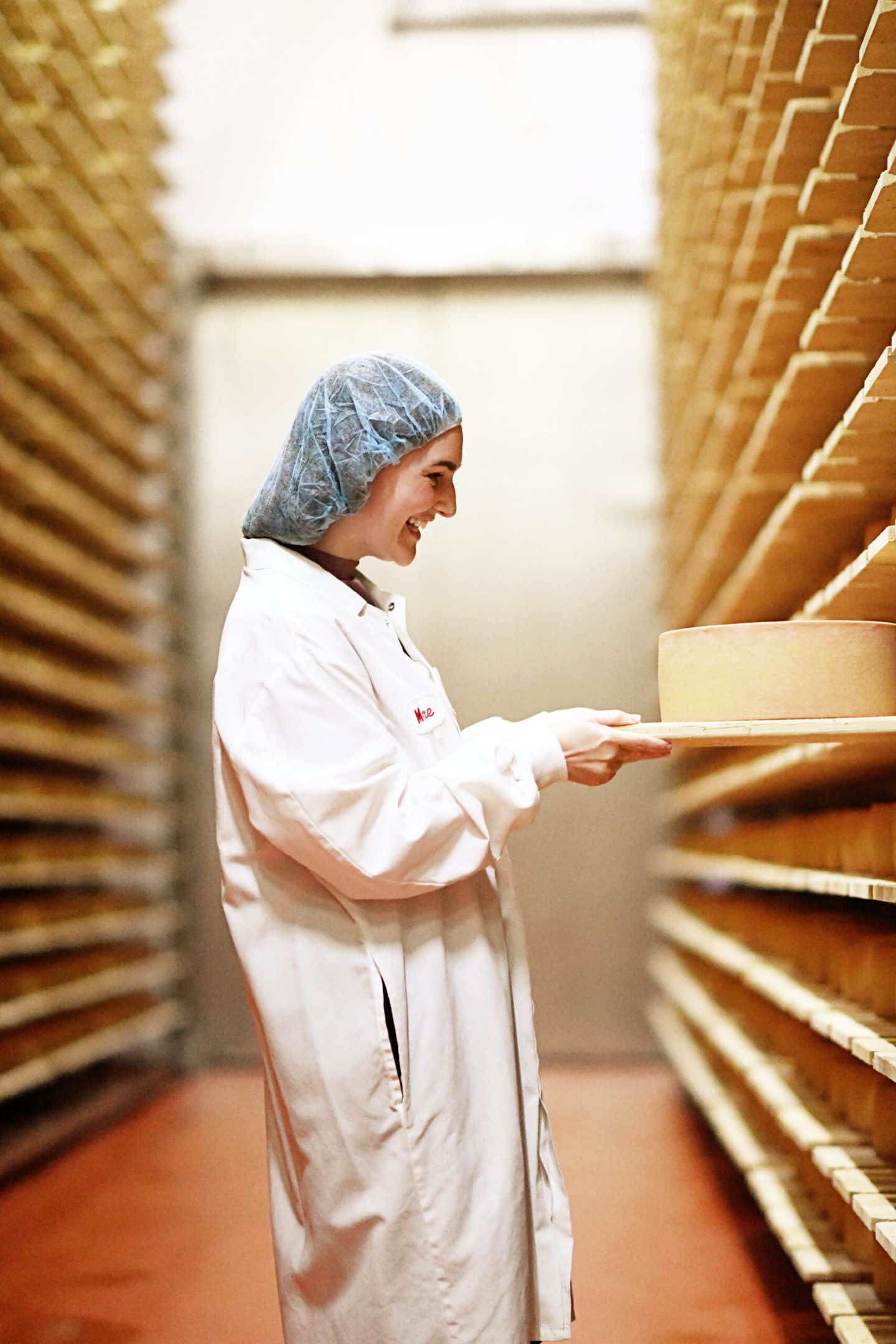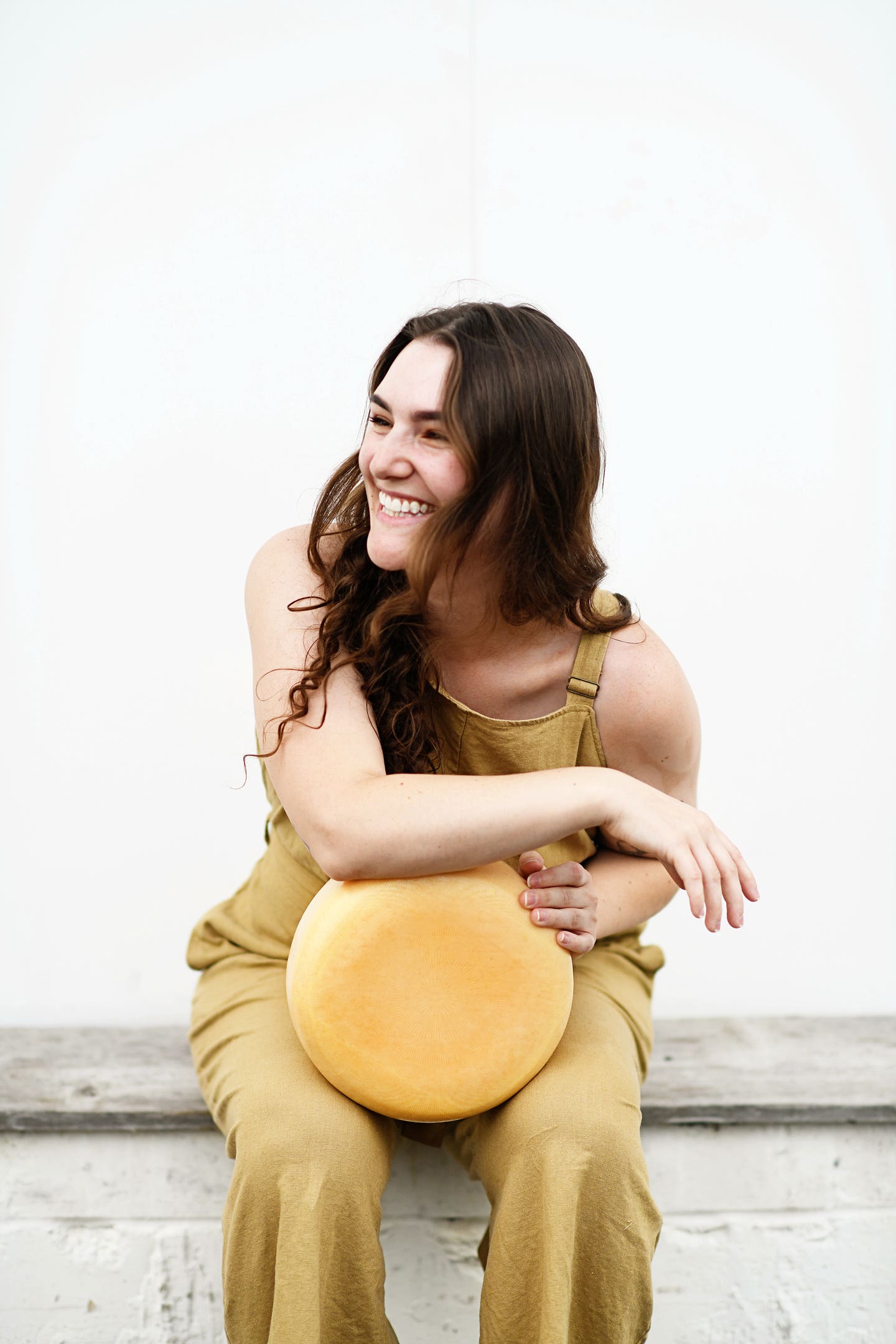A Day in the Life: Meet Wisconsin’s Newest Superstar Cheesemaker
Madeline Kuhn is the next generation of Roth’s renowned cheesemaking legacy. See what she’s got soaking, aging, and brining.


Madeline Kuhn yanks open a metal door six times her size. A pungent, acidic, yeasty scent comes trailing outward, but her nose is used to it. “I spend a lot of time down here,” she says, as she takes stock of the shelves weighed down with hunks of cheese. Pale yellow wheels on spruce boards line the walls from floor to ceiling—Roth’s Grand Cru Surchoix, the 2016 World Cheese Champion.
“When I was new, I asked if my desk could be in the cellars. I insisted I was totally fine just hanging out here.” She chuckles, then gives a half sigh. “Yeah, that didn’t materialize.”
Still, Kuhn spends much of her day in these rooms. A 29-year-old research and development technician for Emmi Roth, one of Wisconsin’s most decorated cheesemakers for brands like Roth Cheese and others, Kuhn is a licensed cheesemaker herself. America’s Dairyland, fittingly, is the only state in the U.S. that requires a license to make and sell cheese. Though she grew up on a farm with dairy cows, she never tried cheesemaking prior to stepping through Roth’s doors: “I learned—and fast.”
Nearly seven years later, Kuhn’s touch can be found all across the cellars, conveyor belts, copper vats, and steel shelves of Roth’s Monroe, Wisconsin facility. The company, with roots dating back to the 1860s, processes 400,000 pounds of milk every day—that’s 40,000 pounds of cheese, divvied up across a dozen-plus varieties. Though no two days in Kuhn’s life are quite the same, here’s how Wisconsin’s young cheesemaking superstar spends an average day—honing her craft, dreaming up new cheeses, and continuing Roth’s legacy.

She pipes at dawn.
It’s 3:30 a.m., and Kuhn’s already hard at work. That’s when the pipes are running the type of milk she needs for her latest experiment. All of Roth’s milk comes from nearby, mostly from small, family-owned farms, and all of it gets turned into cheese within 72 hours. If there’s a specific milk Kuhn wants, she’s got to act fast.
Kuhn spends the wee hours of the morning circling a small metal vat roughly the size of a baby’s crib. Whenever she’s cooking up a new recipe, she works in miniature. Miniature to her, that is—enormous to the rest of us. The trial pilot equipment she’s setting up holds 500 pounds of milk, and the vat will eventually birth two 19-pound wheels. (In contrast, the standard-sized vats around her hold 30,000 pounds, pre-cheese.)
It’s a laborious process that takes hours just to prep: She cleans, sanitizes, hooks up pipes, prepares ingredients, gathers and weighs cultures and enzymes, monitors the milk’s temperature and pH, and keeps an eye on the cheese as it forms. It’s equal parts nurturing and scientific, both deeply mathematical and deeply creative.
Once the cheese takes shape, things get a little bit easier to manage, she says, and that’s when she can step away to attend to things like meetings, paperwork, and checking on her other trials and experiments. The fruits of her labor are littered across the facility—cheeses in wheels and blocks with hot-magenta trial tags. To the untrained eye, the tags are enigmatic: ECW v 5. pH target 5.25. Brine in trial. “It’s…rather secretive. Most people don't know what we're working on,” she says.
This cheese she’s dreaming up now will need to age for up to a year. She won’t go into too much detail, partly because she can’t. The cheese doesn’t have a name or story yet.
“It’s what you might call a hybrid cheese,” she discloses. “We’re pulling out flavors and aromas across well-known cheeses and combining them into a different format. It’s one of my favorite realms to play in.”
A world of pure imagination (and delayed gratification).
Clad in a white jacket, goggles, hairnet, hardhat, and boots, Kuhn also runs facility-wide technical support, monitoring production at every stage. Beyond the cellars, there are pasteurization tanks and copper vats (which Roth pioneered in the U.S.), the brine room (“it’s sort of like a cheese spa!”), and aging and storage rooms, where tag after tag hang in the final lurches of judgment. Most of the cheeses never get tasted outside the facility.
“The nature of R&D is that less than 10 percent of what you work on goes anywhere,” she explains, rattling off a plethora of reasons—flavor, color, cost, timing, and stakeholder interest. To succeed in the job, she continues, a cheesemaker has to understand that everything is a learning experience, and that nothing is a failure.
“R&D can get a little weird,” she adds with a laugh. She recalls a cheese so soft it crawled off the boards; the black-garlic experiment that turned out delicious, but gray. “It feels a bit like Willy Wonka sometimes.”
Like the candymaker, Kuhn works in intricate halls, where cave- and river-like systems flow, often quite literally, with cheese. She, too, is a scientist and a chemist—just one who works not in marshmallow rooms but in cellars of fontina. And instead of “invention being 2% butterscotch ripple,” it’s 2% buttermilk gorgonzola.
Unlike Willy Wonka, though, Kuhn has no magic buttons and levers she can press or pull, and no instant gratification for her meticulous work. Roth Aged Gouda, which is Kuhn’s recipe, is just one example: That project took her three years.
It’s a bit of a rollercoaster, she admits, and it’s easy to get attached to long-term projects. “But I don't look at that as a bad thing,” she notes. “I prefer to have that kind of stake in my work—I should be the biggest advocate for everything I create.”
The biggest, perhaps, but certainly not the only. Roth’s cheeses have millions of fans, and if Kuhn keeps at it, she may find her creations cheered on by millions more.
Keep Reading
Continue to Next Story










